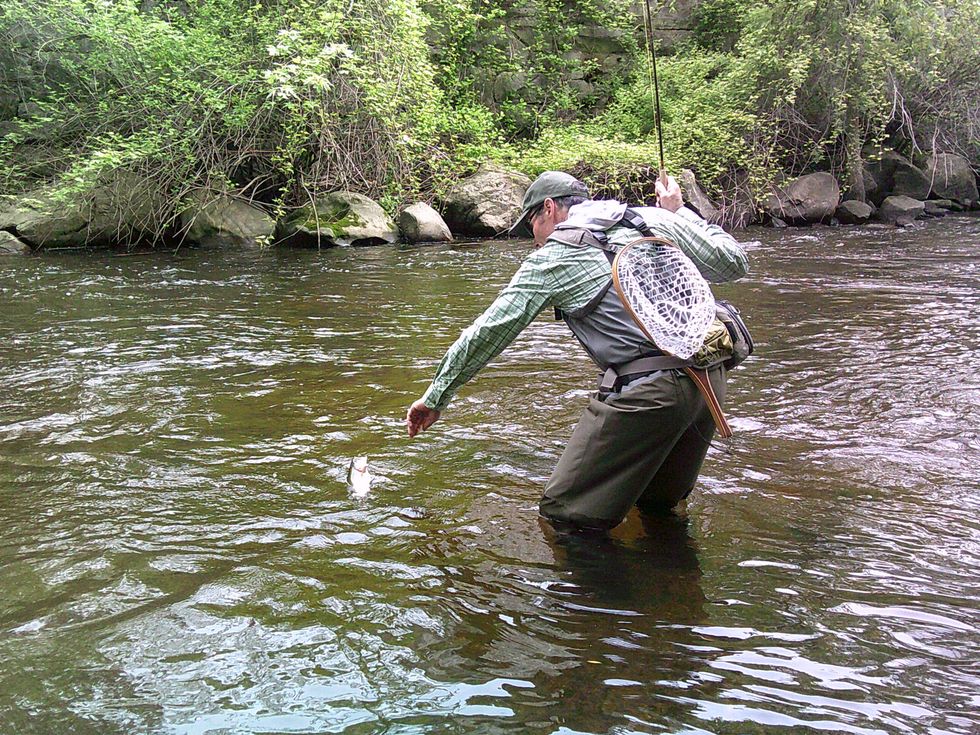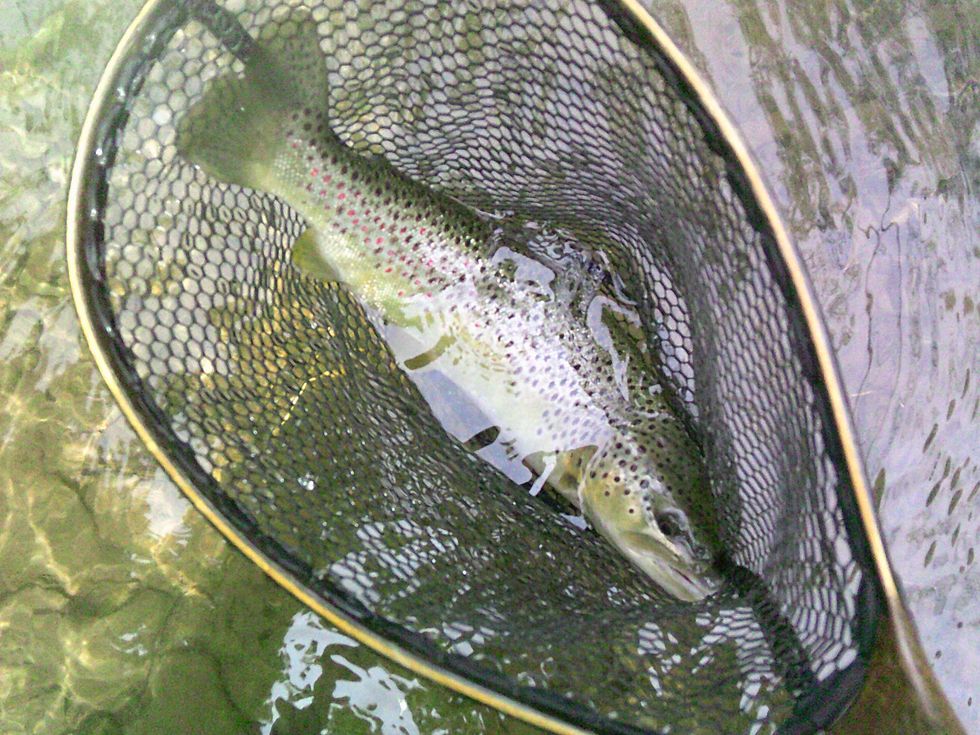Tangled early June 2025

A rock shelf formation on the private stream. This kind of terrain creates excellent cover for trout.
Patrick L. Sullivan

A rock shelf formation on the private stream. This kind of terrain creates excellent cover for trout.
When syndicated columnists get lazy they gather together bits and pieces that never made it out of the notebook, mash them together, and email it in.
Usually they try to unify the disparate items under a catch-all heading, such as “Heard on the Street” or “Things the Cabby Told Me.”
I’m working on that.
A few days before Memorial Day I was whiling away an idle hour or two on the Blackberry.
From the bridge at Beckley Furnace I observed a fellow fly-caster. We acknowledged each other, and after a couple casts he called up “Got any tips?”
I scrambled down. He was Andrew Stone of Illinois, with a teenager at one of the private schools.
I gave him the little mini-bugger I have been using with considerable success in recent years and almost immediately he was on a fish.
This was very good for my ego.

In the last week of May I went on my first solo trip to the private fishing club water. I had my button proclaiming my status as a paid-up member attached to my hat. On advice from the club president, I also made an enlarged photocopy of said button and left it on the dashboard.
The club has an arrangement with property owners along the medium-sized stream. Three members of this particular family drove by at various times, with much waving and tooting of horns.
Armed with an old Orvis seven and a half foot four weight with a slow action and a 10-foot Tenkara rod tucked in my pack, I slithered downstream along surprisingly slick cobble, swinging a team of traditional winged wet flies below me.
Nothing happened.
Then the stream took a hard left into a long shelf formation, and here I struck gold.
Alertly noticing the casings from a bug called isonychia on the streamside rocks, I changed over to a Leadwing Coachman winged wet fly on a dropper under an iso dry fly.
I like isos. They are big, and their imitations are big too. I can see them to tie on.
Isos are also good swimmers, so instead of obsessing about the perfect drift, I can put some English on them, especially the subsurface versions.
There are typically two rounds of isonychia in the streams I frequent in New York and Connecticut. The first starts around the beginning of June and seems to taper off as July approaches.
Then it all starts again in August, and runs for a couple months. I have caught fish in the Esopus and Housatonic in late October on iso imitations.
The first brown nabbed the wet fly, and a few minutes later another sportingly took the dry.

After an unfortunate encounter with some knotweed I switched over to the DragonTail Talon Mini 310, which is a fixed-line rod with a slow action that fishes at 10 feet and packs down to 12 inches when collapsed, which means it can be stuck in a shallow pocket on a vest or in the wader’s handwarming pocket or even in a pants pocket
The extra reach allowed me to simply flick the line back and forth in front of me, thus avoiding a back cast and the dratted knotweed.
Using a team of a yellow soft hackle wet in size 14 and the Leadwing, I rustled up a couple more of the truck fish from the stocking the first week of May. Neither paid any attention to the yellow fly, which I only included because I saw a yellowish bug flying around. This is called “Not Matching the Hatch.”
Back at base I next spent a thoroughly frustrating day failing to catch anything anywhere on a day that should have been perfect — overcast, warmish, drizzly. The kind of day that makes aquatic insects leap from their beds and rejoice in the promise of a new day.
After a solid five hours of fooling around I finally found some wild browns who were willing to play. They weren’t big but they were very wiggly, resulting in many “compassionate releases,” which is a convenient rationalization of the failure to land a fish.
Speaking of failure, I forgot to buy milk. Twice. So on two successive mornings I had to drink my coffee black.
I remembered to buy a quart, figuring I could bring it back to Connecticut in the cooler.
Well…
Let’s just say that as I peck this out on a rainy Saturday morning, May 31, I am enjoying a cup of black coffee.
The Salisbury Winter Sports Association (SWSA) will host its annual Junior Jump Camp, a two-day introduction to ski jumping, on Saturday and Sunday, Dec. 27 and 28, from 9 a.m. to 2 p.m. at Satre Hill in Salisbury.
The camp is open to children ages 7 and up and focuses on teaching the basics of ski jumping, with an emphasis on safety, balance and control, using SWSA’s smallest hill. No prior experience is required.
The cost is $50 per child and includes instruction and lunch on both days. For more information or to register, visit www.skireg.com/swsa-camp or email info@jumpfest.org
Jesse Bunce, first selectman of North Canaan.
LITCHFIELD — The Northwest Hills Council of Governments welcomed six newly elected municipal leaders Thursday, Dec. 11, at its first meeting following the 2025 municipal elections.
The council — a regional planning body representing 21 towns in northwest Connecticut — coordinates transportation, emergency planning, housing, economic development and other shared municipal services.
Barkhamsted First Selectman Meaghan Cook, Goshen First Selectman Seth Breakell, Kent First Selectman Eric Epstein, Norfolk First Selectman Henry Tirrell, North Canaan First Selectman Jesse Bunce and Torrington Mayor Molly Spino were each elected to their post in November.
They filled the seats of their predecessors on the COG, who were each given a toast of appreciation: Nick Lukiwsky (Barkhamsted), Todd Carusillo (Goshen), Marty Lindenmeyer (Kent), Matt Riiska (Norfolk), Brian Ohler (North Canaan) and Elinor Carbone (Torrington).
COG Executive Director Rob Phillips said the outgoing members were given a going away mug that read “You’re living the dream still.” Members voted to appoint Warren First Selectman Greg LaCava to fill a vacancy on the Council’s Executive Committee. COG members voted by paper ballot, and LaCava defeated Burlington First Selectman Doug Thompson for the vacant seat.
Ryan Segalla takes a fadeaway shot over a defender.
FALLS VILLAGE — Housatonic Valley Regional High School’s boys basketball team defeated Pine Plains High School 60-22 in a scrimmage Tuesday, Dec. 9. The non-league preseason game gave both sides an opportunity to run the court ahead of the 2025-26 varsity season.
HVRHS’s senior-heavy roster played with power and poise. The boys pulled ahead early and kept their foot on the gas through to the end.
By halftime the score was 33-8. Junior varsity players subbed in for the second half, but not before the starters got some in-game dunk practice. By the end Housatonic totaled 60 points to Pine Plains’ 22.

Nick Crodelle led the Mountaineers offensively with 13 points. Anthony Labbadia and Wyatt Bayer scored nine points each. Anthony Foley scored eight points. Owen Riemer and Ryan Segalla each scored seven points. Peyton Bushnell hit a three-pointer. Jaxon Visockis and Henry Berry each scored two points.
HVRHS begins Berkshire League competition on the road at Nonnewaug High School Tuesday, Dec. 16, with a 6 p.m. tip off.


Katie Moore delivers toys to the Stuff a Truck campaign held by the Kent Volunteer Fire Department last weekend. Donated toys are collected so that parents, who need some assistance, may provide their children with gifts this Christmas. Accepting the donation are elves Fran Goodsell and Karen Iannucci
KENT — Santa’s elves were toasty warm as they collected toys for the children of Kent.
Keeping with annual tradition, Fran Goodsell and Karen Iannucci manned the Stuff a Truck campaign sponsored by the Kent Volunteer Fire Department on Saturday, Dec. 6, and Sunday, Dec. 7. Sitting in front of a fire pit in the firehouse parking lot between donations from residents, they spoke of the incredible generosity displayed every season. That spirit of giving was clear from the piles of toys heaped on a table.
“This is always so gratifying,” said Goodsell, noting that certain businesses, including High Watch Recovery Center, Wilson’s, and Kent and South Kent schools needed a “shout out” for all they’ve done. She said South Kent School focuses on gifts for older children, which is a group that often is overlooked.
Unwrapped contributions are sought for children 1 to 15 years old who might otherwise find little or nothing from Santa, they said. The bounty will be set up at the Community House on Thursday, allowing parents to come and take what they want. If there are still items left, grandparents are invited to “shop.”
The atmosphere was festive Saturday, as a stuffed dog began barking a Christmas tune whenever someone walked in front of it. A large decked-out bear posted at the parking lot entrance reminded passersby of the event. Visiting children were able to get a close-up look at the fire truck and walk through the firehouse if they wished.
Goodsell and Iannucci were very grateful to those who donated wood for the fire pit. “And so many asked if they could bring us coffee or hot chocolate,” said Iannucci.
Goodsell said many who came talked about having grown children who were recipients of the gifts when their families were struggling. “They are so glad to be able to give back,” she said.